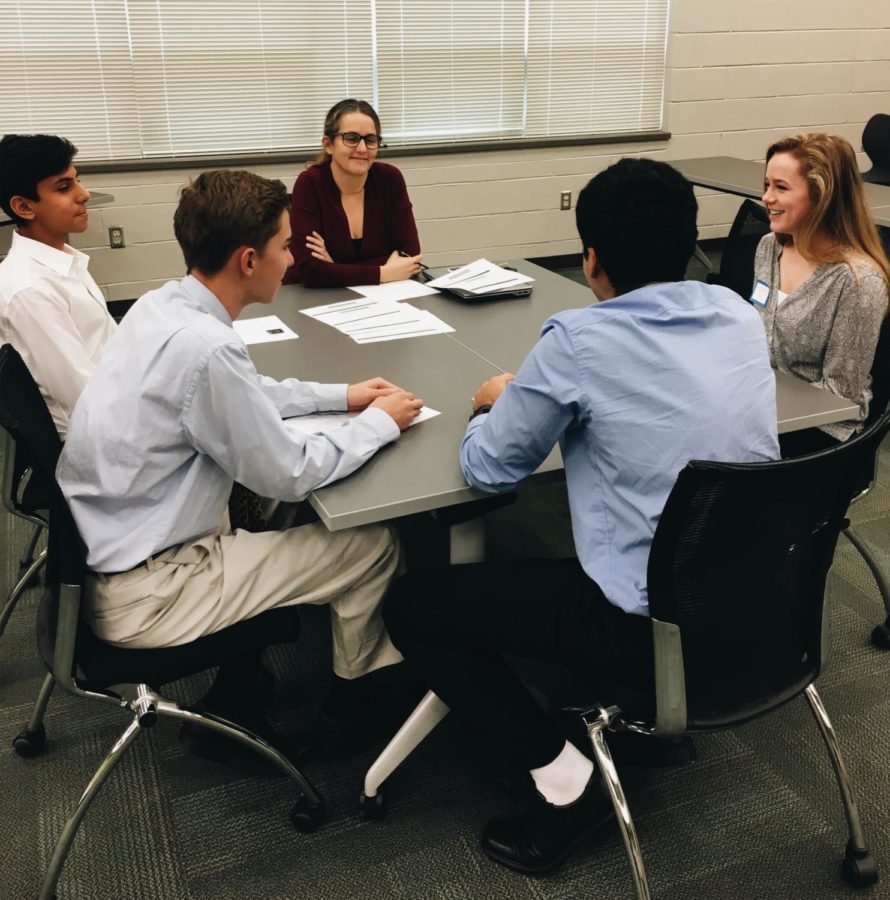New School Policy Means You Have 21 New Group Projects To Do!
Why all Langley teachers must assign at least 3 group projects or PBLs in their courses
A project based learning assignment with some of Ms. Kathleen Stankiewicz’s students
Most Langley students have already completed at least one project-based learning assignment or a PBL. Often times though, students do not realize the project that they have completed was a PBL. From most students’ perspectives, PBLs are very similar to any normal project completed in class. So what is it that makes a PBL different? According to research done at the Buck Institute for Education (BIE), PBLs can be much more effective than a standard research paper or project. The BIE website breaks up what makes a PBL into eight sections: Key Knowledge, Challenging Question, Sustained Inquiry, Authenticity, Student Voice and Choice, Reflection, Critique and Revision, and finally Public Product.
All PBLs are formed by an essential question. The question can be straightforward or abstract but should draw student interest. In the past, teacher Ronni Chern, has had her English class answer the question: “If you have committed a crime, what should happen?” The question enables students to make powerful observations in an open-ended format.
“Most people think of PBL as the project, it’s not,” Chern said. “The project is the question that drives us.”
The next step to a PBL is Sustained Inquiry. During this stage of the process, students are encouraged to ask questions and use their resources to find answers to them. Students are encouraged to use multiple resources to answer their questions, such as books, websites, or documentaries.
Authenticity comes into the picture during the design of the project. It guarantees students will have to use real-world skills in order to answer the question. Another way to incorporate authenticity into a project is using a real-world problem. Kathleen Stankiewicz, Langley’s second PBL coordinator, led her World 2 class in a PBL where they were to construct a monument to commemorate World War II and its effects around the world. The real-world prompt gives this PBL its authenticity.
“I do think that [PBL] gives [students] the opportunity to explore some skills that they may not necessarily connect with history,” Stankiewicz said.
After students have gathered information about their topic, it is time for them to determine how they will formulate their project. BIE calls this Student Voice and Choice. This step allows students to voice their opinions on the matter and choose how to best answer the question. Being able to call the shots gives students control over their project.
“We want students to… have opportunities for choice and voice. Choice is how you do it, and Voice is what you say,” Chern said.
Reflection encourages students and teachers to take a step back and consider the effectiveness of the project. Looking back on what worked and what did not can help both students and teachers to improve on their next PBL.
Critique and Revision are the second to last component of the PBL. Students should integrate comments on their projects into their work, keeping things that worked and improving what did not. During this time, students are urged to critique both their projects and their peers, prompting constructive criticism.
“What students don’t know is [that] there are constantly opportunities for learning for teachers,” Chern said.
The last step of a PBL is Public Product. With this, students must share their work with external sources for outside opinions and feedback. Ideally, students would be able to share their projects with experts on the topic.
At Langley, the PBL program has not been in place long enough yet to determine how well the BIE goals and guidelines are being implemented.
“I think PBLs have the potential to encourage students to create meaningful assignments,” Ryan Jackson, history teacher said. “But with [the] limitations of our schedule, and the structure of our current educational system, I wonder if the projects themselves are meaningful and can deliver all elements–such as presentation to a knowledgeable audience or real-world practicality. Or are we creating long term projects for kids to work in groups?”
A key example of a standard PBL is the 10th grade Honors English Promptbook Project, where students are asked to perform selected scenes of Macbeth. In the past, an actor from the Kennedy Center has come out to provide advice and analyses to the students.
“I enjoyed the Macbeth prompt book project, for the most part. But I don’t feel like I learned anything extra from that project,” Sophomore Campbell Duncan said.
“I feel like PBLs are like a hit or miss thing,” said sophomore Keon Parastaran. “It can either turn out to be a unique and engaging experience or a complete disaster, depending on the subject, the people in your group, [and] how it’s structured.”
Regardless, most Langley students can agree with Parastaran when he says, “I’d choose [a PBL] over an essay in a heartbeat!”


